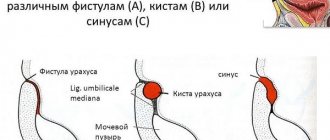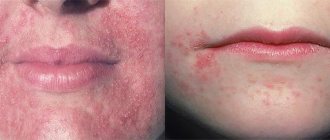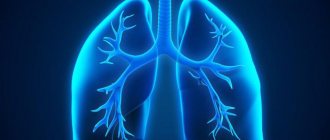Non-parasitic liver cyst (NPLC) refers to benign focal formations of the liver and is a cavity in the liver filled with fluid.
Currently, non-parasitic liver cysts are detected in 5–10% of the population. Moreover, in women they occur 3–5 times more often. The disease usually develops between 30 and 50 years of life.
True and false cysts are distinguished. True cysts differ from false ones by the presence of an epithelial cover of columnar or cubic epithelium on the inner surface. False cysts usually develop after injury.
Main characteristics of the disease
A cyst is a benign hollow lesion that has a connective tissue capsule and is filled with fluid. There are no symptoms until the cyst reaches its maximum size or its capsule ruptures.
The internal cavity of the formation is lined with cells that are similar to the tissues of the biliary system. The cyst is filled with exudate, which is odorless and colorless. Less commonly, the neoplasm contains a jelly-like mass. The liquid may turn brownish-green in color. In this case, it consists of epithelial cells, bilirubin, fibrin, cholesterol and mucin. When an infectious agent penetrates inside, the contents of the neoplasm become purulent, and when hemorrhaging becomes hemorrhagic.
Simple cysts can be located both on the surface of the organ and in the deep layers. Dimensions from several mm. up to 2.5 cm. Giant formations are less common, more often in women. When the cyst is small, the liver tissue around it remains unchanged, but when the cyst is large, the cystic cavity compresses the parenchyma and surrounding tissue, which leads to atrophic processes.
How dangerous is a neoplasm?
A small and stable cyst does not pose a serious danger, but multiple ones cause damage to a large area. A large and rapidly developing cystic cavity is also dangerous, which leads to severe symptoms and loss of liver function. Likely:
- rupture of cystic formation;
- inflammation;
- spread of parasites.
Such complications provoke an abscess, blood poisoning, parenchymal necrosis, and death.
Nosological forms
Liver cysts are classified as follows:
- in accordance with the etiological factor - parasitic and non-parasitic;
- by the number of lesions - single and multiple;
- according to the nature of the course - uncomplicated and complicated.
Each type of education is divided into several subtypes.
Parasitic
They develop when tapeworms penetrate the internal organ. This form mainly affects people living in countries where agriculture is developed. The cause is the consumption of unwashed food and contact with infected animals (livestock, cats, dogs).
Types of parasitic neoplasms:
- Echinococcal. The causative agent is the larvae of Ehinocococcus granulesus. From the stomach with the blood they are transferred to the liver, where they continue to develop. An hydatid cyst is characterized by a cloudy exudate and the presence of daughter blisters inside (see echinococcosis).
- Alveococcal. The causative agent is Ehinokokkus alveolaris. Larval forms penetrate from the stomach into the capillary network of the liver, where they begin to develop. The parasite is widespread in taiga regions. Infection occurs through contact with animals (foxes, wolves, dogs and arctic foxes). An alveococcal cyst develops mainly in the right lobe of the liver.
Infection occurs exclusively through animals or food products infected with larvae. The parasite cannot be transmitted from one person to another.
Non-parasitic
Formations have their own classification and are:
- Congenital (true) - tumors that arose during intrauterine development.
- Acquired (false) - have an etiology of an inflammatory or traumatic nature. Develop after surgery, with an abscess or echinococcosis.
Congenital
True liver lobe cysts are classified as follows:
- Solitary - has a round shape and is located in the lower part of the right lobe. It is distinguished by the presence of a stalk, through which it hangs into the peritoneal cavity. Complications are possible: cyst torsion, hemorrhage, malignancy, rupture and suppuration.
- Polycystic disease is a consequence of a genetic mutation. Neoplasms can vary in size and spread diffusely throughout the liver. They increase throughout a person’s life and cause functional liver failure, esophageal varices and portal hypertension.
- Cystic fibrosis is the most severe form of the disease, which occurs mainly in newborns. Not only the liver is affected, but also the main vein (portal vein). With cystic fibrosis, there is a possibility of growth into many bile microcysts.
Purchased
They develop during life after birth and are of the following types:
- Inflammatory (liver abscess) - most often occurs after an acute form of phlegmonous cholecystitis. It poses a danger to human life. Occurs only when immunity decreases.
- Post-traumatic - formed as a result of injury and are cavities containing fluid (bile or blood). They form immediately after mechanical damage and are not similar in appearance to a regular cyst. Over time, a cavity appears around the formation.
With acquired cysts, complications such as suppuration and prolonged bleeding are possible. In the second case, an increase in the size of the formation is observed. The contents of the neoplasm are represented by liquid and fibrin threads.
Single and multiple
Single cysts include solitary true neoplasms that have an epithelial lining and reach 3 cm in diameter. They do not increase in size and are not an indication for surgical intervention. In this case, systematic observation is recommended, since there is a possibility that the tumor is modified into malignant.
Multiple cysts are polycystic neoplasms that change the parenchymal outline of the shape. They are quite dangerous because they lead to the development of functional liver failure.
Types of neoplasms
Oncologists adhere to a certain classification of cystic tumors. First of all, they stand out:
- True. It is distinguished by its congenital nature and the presence of a specific “lining” inside the epithelial layer.
- False. Appears under the influence of external factors - liver injury, surgery, inflammation. In this case, the soft tissues of the organ undergo changes, which becomes a provocateur of a benign formation.
Depending on the structure, it is diagnosed:
- A simple liver cyst is a single tumor.
- Multi-chamber - the internal space is divided by partitions.
- Polycystic disease is a small cystic formation that affects one area or different segments.
The most general classification divides all cystic formations into:
- parasitic (echinococcal, alveococcal);
- non-parasitic.
When the liver is damaged by helminths and specific cavities form, it is important to prevent the spread of parasites through the bloodstream to other organs.
Causes
What causes liver cysts? There is no consensus on the factors that provoke the development of true non-parasitic liver cysts.
Presumably formations occur in the following cases:
- in case of intoxication of the body;
- with genetic predisposition;
- during infectious processes (rubella, jaundice, adenovirus infection);
- against the background of alcoholic hepatitis, cirrhosis, cholelithiasis, polycystic disease;
- during embryogenesis against the background of hyperplasia of the bile ducts, followed by their blockage and obstruction;
- when using contraceptives and hormonal drugs containing estrogens.
There is a theory that explains the development of neoplasms from intralobular and interlobular ducts. They are not included in the biliary tract system during embryonic development. The epithelium of the closed cavity secretes a secretion that promotes the accumulation of exudate and turns them into cysts.
False cysts appear due to mechanical damage to an internal organ. The cause of the disease can be surgery and necrosis. In the case of parasitic cysts, development occurs against the background of an amoebic abscess and damage by echinococcus.
Pathogenesis
The formation of a parasitic cyst from the moment of infection includes 3 stages:
- Penetration of the parasite first into the blood and then into the hepatic system, forming a cyst capsule with small contents. At this stage, the liver is able to fully perform its functions, the immune system works as usual. The stage is completely asymptomatic.
- An increase in the size of the tumor, the formation of a specific stalk, which falls into the abdominal cavity. The tumor reaches such a size that it begins to compress the liver and nearby organs, causing severe pain to the patient.
- Rapid progression of the process, which is accompanied by a pronounced inflammatory process around the cyst and subsequent suppuration. In rare cases, it is at this stage that the cyst ruptures with damage to the liver structures.
Symptoms and signs
With single small liver cysts, there are usually no symptoms. Primary manifestations occur with multiple formations and when the tumor reaches 7-8 cm.
Nonspecific symptoms:
- nausea and vomiting;
- flatulence and diarrhea;
- increased sweating;
- myalgia (pain in the muscle area);
- general weakness and malaise;
- the appearance of shortness of breath after physical exertion;
- heaviness in the right hypochondrium and belching after eating;
- loss of appetite, complete refusal of food is possible;
- increase in body temperature to subfebrile levels.
When a giant cyst forms, specific symptoms appear that are unique to this disease. We are talking about asymmetric enlargement of the abdomen and liver, jaundice, itching and sudden weight loss.
Symptoms
Cystic formations in the liver are rarely accompanied by a pronounced clinical picture. Many patients whose tumor does not grow live their entire lives with a benign tumor, without even knowing about its presence. Usually the problem is revealed only during examination for another reason.
But if the cyst is actively growing, characteristic signs often appear:
- Pain in the upper abdomen on the right. If you do not receive medical help at this stage, the pain will become cramping.
- Decreased appetite and resulting weight loss.
- Manifestations of obstructive jaundice. The accumulation of bilirubin in the blood provokes a characteristic shade of the skin and eye sclera.
- From the gastrointestinal tract, symptoms appear in the form of belching, nausea and diarrhea, and flatulence.
- Even with little physical activity, shortness of breath is noted.
- The person experiences muscle weakness and gets tired easily.
- For no apparent reason, body temperature rises.
The pain syndrome increases significantly when traveling on uneven roads or during physical work.
A cyst of significant size provokes an asymmetrical enlargement of the abdomen.
In this case, urgent medical attention is necessary. Growing rapidly, the cyst destroys healthy tissue, and insufficient liver functionality causes death. Severe symptoms mean that cystic formations have affected approximately 20% of the liver volume or there is a single tumor, the size of which reaches 7 cm.
Sometimes a cyst makes itself felt with a nonspecific symptom - profuse sweating. The formation, located in the liver near the bile ducts, provokes darkening of the urine and discoloration of the stool. With a large cyst, the liver increases in size, which is determined by normal palpation during examination by a doctor.
Delaying the treatment of a progressive cyst sometimes leads to rupture of liver tissue. In this case:
- A sharp, short-lasting pain is felt.
- Relief follows, accompanied by weakening of the muscles.
- Cold sweat appears.
- There is a noise in the ears, spots flash before the eyes.
- Often a person loses consciousness.
If such a clinical picture is present, urgent help is needed. A team of doctors is called and transports the person to the inpatient department. Delay can be fatal.
Possible complications
Why is a liver cyst dangerous? The disease can have a complicated course, which is characterized by:
- hemorrhage into the wall or cavity of the formation;
- torsion of the cyst stalk, perforation or suppuration;
- malignant degeneration (occurs extremely rarely).
When a formation ruptures or internal hemorrhage occurs, a condition occurs that is accompanied by intense abdominal pain. In this case, there is a danger of developing peritonitis or bleeding into the peritoneal cavity. This condition is accompanied by acute pain and rapid intoxication syndrome, leading to death.
With hemorrhage, pale skin, dizziness and increased heart rate are observed. There is a decrease in blood pressure to the point of collapse (deterioration of blood supply to internal organs).
Establishing diagnosis
If symptoms of a liver cyst occur, you should first go to a general practitioner, who, if necessary, will refer you to a specialized specialist: a surgeon, hepatologist or gastroenterologist.
Before treating a liver cyst, it is necessary to undergo a complete examination. The doctor will collect an anamnesis of the disease, perform palpation and prescribe a number of laboratory tests and instrumental studies:
- Ultrasound of the liver
- Percutaneous puncture of the formation.
- Bacteriological and cytological examination.
- Liver scintigraphy.
- MRI
- Angiography of the celiac trunk.
The research methods used make it possible to diagnose and differentiate the cyst from metastatic lesions of the liver, hydrocele of the gallbladder, tumors of the mesentery, pancreas and small intestine. To exclude parasitic infestations, a serological blood test (ELISA, RNGA) is performed.
When a liver cyst reaches 7-10 cm, a negative effect occurs on the parenchyma of the internal organ, which leads to dysfunction (as a result of the pressure exerted). Clinically, the pathology manifests itself as changes in the biochemical parameters of the blood. A cyst in the left lobe is often accompanied by a hiatal hernia, and a cyst in the right lobe is often accompanied by bursting pain in the lumbar region.
Our doctors
Gordeev Sergey Alexandrovich
Surgeon, Candidate of Medical Sciences, doctor of the highest category
41 years of experience
Make an appointment
Lutsevich Oleg Emmanuilovich
Chief Surgeon of CELT, Honored Doctor of the Russian Federation, Chief Specialist of the Moscow Department of Health in Endosurgery and Endoscopy, Corresponding Member of the Russian Academy of Sciences, Head of the Department of Faculty Surgery No. 1 of the State Budgetary Educational Institution BPO MGMSU, Doctor of Medical Sciences, Doctor of the Highest Category, Professor
42 years of experience
Make an appointment
Prokhorov Yuri Anatolievich
Surgeon, head of the surgical service of CELT, candidate of medical sciences, doctor of the highest category
32 years of experience
Make an appointment
Treatment
Liver cysts require an integrated approach to treatment:
- symptomatic drug therapy;
- surgical removal;
- dieting.
For neoplasms that reach no more than 3 cm in diameter and have no symptoms, dynamic monitoring (periodic CT and ultrasound) is recommended. For formations from 4 to 6 cm, drug therapy is required.
Medicinal treatment of liver cysts is carried out using Analgin for pain relief and Mebendazole for parasitic forms of the disease. To restore the liver, hepatoprotectors are prescribed (see List of all medications for the liver, Essentiale Forte, Phosphogliv). To relieve the inflammatory process, NSAIDs (Diclofenac, Ketoprofen) are used under the guise of Omeprazole and its analogues to avoid gastrointestinal bleeding.
Hormonal medications and agents that strengthen the immune system, such as Immunal, are prescribed. Treatment of liver cysts with medications, carried out under the supervision of an experienced doctor, leads to a positive outcome of the disease.
Forecast
The prognosis after operations performed to remove a cyst is often favorable. To prevent consequences, you should visit a doctor at least once a year.
If the diagnosis of liver cyst is confirmed, there is no need to panic. The disease in its very first stages is not dangerous to health and does not require medical procedures. However, you should always remember about the possibility of an increase in the size of the cyst and what consequences this may have for your health. You should not delay visiting a doctor and ignore his advice and recommendations.
As a rule, re-growth of cysts is not detected. In the rarest cases, liver cysts may reappear, in which case more serious treatment will be required.
After six months, the patient will be able to return to his normal, familiar way of life.
Surgical removal
Surgery is necessary if there is a formation measuring 7 cm or more. Indications for surgical intervention are bleeding, rupture of the cyst wall and impaired bile outflow. The operation is performed in cases of suppuration, the development of portal hypertension and a deterioration in the quality of life due to the presence of pronounced symptoms.
Liver cyst surgery can be of the following types:
- Radical – resection or transplantation (for severe polycystic disease).
- Palliative – percutaneous puncture for the purpose of sclerosis.
- Conditionally radical – excision of the walls of the formation or enucleation.
In 90% of cases, laparoscopy is performed (insertion of instruments through small punctures in the abdominal wall). The minimally invasive technique is used for non-parasitic and uncomplicated cysts, the size of which is 5-20 cm, and only if the formations are located on the periphery of the organ.
The essence of laparoscopy is excision of the walls of the tumor within healthy tissues, without performing liver resection, which eliminates disruption of the functions of the internal organ. With congenital polycystic disease, only large tumors are excised. This approach allows you to achieve only a temporary result, but helps improve the functioning of the liver parenchyma.
Diagnostics
Most often, pathology is detected randomly - when performing an ultrasound of the abdominal organs, neoplasms in the liver are easily detected. If diagnostics are necessary to confirm the diagnosis, the following examinations are sometimes prescribed:
- Computed tomography () – to clarify the location, structure and size of cysts.
- Puncture of the cyst followed by laboratory examination of the contents.
- Angiography is a study of liver vessels with a contrast agent.
- Liver scintigraphy.
Diagnostics allows not only to confirm the diagnosis (cysts are also noticeable on ultrasound), but also to determine its type. The differentiation of benign neoplasms from malignant ones, as well as from tumors of the intestine and other internal organs, is also of great importance.
If there is a suspicion of a parasitic origin of the cyst, then a serological blood test is prescribed. If additional data is required, diagnostic laparoscopy may be prescribed - a study that is performed through a puncture. It can be combined with surgery to remove the cyst.
Therapeutic and restorative diet
You need to adhere to proper nutrition both when a formation is detected and after removal of a cyst. The diet reduces the load on the organ, prevents hepatosis, cholecystitis and normalizes digestion processes.
You need to completely avoid alcoholic beverages, fatty, fried, smoked foods and canned foods. It is strictly forbidden to drink carbonated drinks and coffee, or eat sweets.
The daily menu should include fresh vegetables, fruits and herbs. Low-fat fermented milk products should be included in your diet.
Principles of dietary nutrition for liver cysts:
- The daily intake of easily digestible protein is at least 120 g.
- The daily diet should contain fat - 80 g, carbohydrates - 450 g.
- You need to steam, bake without crust or boil.
- Meals should be small and frequent - from 5 times a day.
- The energy value of the daily diet is no more than 3,000 Kcal.
The above diet principles are recommendations. Therapeutic nutrition must be formulated for each patient separately.
Traditional therapy
Alternative medicine is used in the fight against liver cysts as an auxiliary measure that increases the effectiveness of the main treatment. This approach to therapy involves the use of medicinal plants. The result of alternative treatment can be noticed only after 45-55 days.
Medicinal plants used for liver cysts:
- bloody (upper part);
- mother herb (flowers);
- milk jug (root);
- peppermint (leaves);
- zhoster (bark);
- jeera (fruit).
Based on the listed medicinal plants, you can prepare decoctions and infusions. To do this, you need to pour boiling water (100-200 ml) over the dry crushed raw materials (1-2 tablespoons), keeping them in a water bath for 5-7 minutes or leaving them in a closed container for half an hour.
The prognosis for liver cysts, even with the development of complications, is favorable only with successful surgical intervention. Lasting recovery can only be achieved with radical surgery. Prevention is only possible in the case of parasitic cysts and involves deworming.
Is a cyst in the liver a tumor or not?
A liver cyst is a benign tumor that is completely treatable. The main thing is not to miss the moment of its appearance and control the condition and size of the tumor in order to prevent serious consequences.
The team of doctors at the Yusupov Hospital, based on the latest advances in medicine, will draw up a plan for adequate and effective therapy, or prescribe a method of surgical intervention that is suitable for a particular patient in accordance with his clinical picture and general health.









